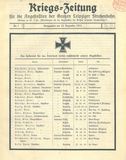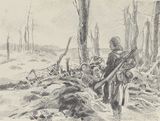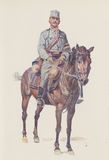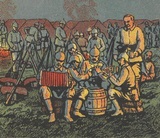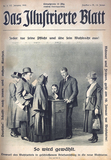War Newspapers
As an important part of propaganda, wartime newspapers also served to (self) mobilise the soldiers and the population. Their spectrum was wide-ranging, making it impossible to know all of the German periodicals in their entirety.
War Painting and Graphics
War art primarily reflected the experiences at the front. Idealisation and interpretation took second place behind the reporting of events. Field reports were completed with crayon and palette.
War Pictures Exhibition, 1917
Third war exhibition by the Deutsche BüchereiThe third exhibition by the Deutsche Bücherei was obviously inspired indirectly by the activities of the German Museum of Books and Writing, which had become involved in 1916 in the state-organised Deutsche Kriegsausstellungen - German War Exhibitionsin Schwerin, Rostock, Bremen, Dresden and other cities, and had received much gratitude and appreciation from the public.
War Poetry and War Songs
A lyrical floodThe First World War produced a large amount of poems and songs. The literary critic Julius Bab estimates that around 50,000 poems were submitted to magazines and newspapers in the first weeks of the war.
War Propaganda in Children’s and Juveniles’ Books
As well as at school, the auxiliary aid services on the home front, and the paramilitary exercises of youth clubs, children and adolescents were also manipulated by propaganda in their free time by a wide range of recreational literature, which presented the war as a great adventure and a test of manliness. Colouring books for infants presented the children with enemy figures.
Wartime Captivity
In many of the countries that went to war, the military authorities assumed in the summer of 1914 that it would be a short war, so that hardly any preparations were made for accommodating a large number of prisoners of war. The German military leadership, for example, expected the number of prisoners to be accommodated to be no more than 160,000 men, basing their estimate on the experience of the Franco-Prussian War of 1870/71. But by the turn of the year 1914/15, the German authorities were already housing 577,875 prisoners of war.
Women's suffrage
All citizens over 20 years of age had the right to vote and stand as a candidate in the German National Assembly election on 19 January 1919. This fulfilled the old demand of one section of the German women's movement.
World War Catalogue
The register, conceived as a separate catalogue, was intended to record the entire war literature systematically. The preliminary work for such a system was carried out in 1920, whereby an initial structure originally foresaw 39 main and around 1,500 sub-categories.
